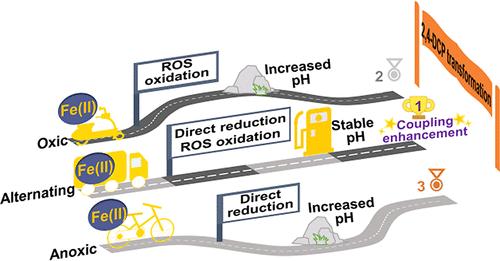当前位置:
X-MOL 学术
›
Environ. Sci. Technol.
›
论文详情
Our official English website, www.x-mol.net, welcomes your
feedback! (Note: you will need to create a separate account there.)
Natural Attenuation of 2,4-Dichlorophenol in Fe-Rich Soil during Redox Oscillations: Anoxic–Oxic Coupling Mechanism
Environmental Science & Technology ( IF 10.8 ) Pub Date : 2024-07-19 , DOI: 10.1021/acs.est.4c03244 Jingyi Zhang 1 , Xiaoyun Xu 1 , Jun Liang 1 , Wenfeng Huang 1 , Ling Zhao 1 , Hao Qiu 1 , Xinde Cao 1, 2, 3
Environmental Science & Technology ( IF 10.8 ) Pub Date : 2024-07-19 , DOI: 10.1021/acs.est.4c03244 Jingyi Zhang 1 , Xiaoyun Xu 1 , Jun Liang 1 , Wenfeng Huang 1 , Ling Zhao 1 , Hao Qiu 1 , Xinde Cao 1, 2, 3
Affiliation

|
Natural attenuation of organic contaminants can occur under anoxic or oxic conditions. However, the effect of the coupling anoxic–oxic process, which often happens in subsurface soil, on contaminant transformation remains poorly understood. Here, we investigated 2,4-dichlorophenol (2,4-DCP) transformation in Fe-rich soil under anoxic–oxic alternation. The anoxic and oxic periods in the alternating system showed faster 2,4-DCP transformation than the corresponding control single anoxic and oxic systems; therefore, a higher transformation rate (63.4%) was obtained in the alternating system relative to control systems (27.9–42.4%). Compared to stable pH in the alternating system, the control systems presented clear OH– accumulation, caused by more Fe(II) regeneration in the control anoxic system and longer oxygenation in the control oxic system. Since 2,4-DCP was transformed by ion exchangeable Fe(II) in soil via direct reduction in the anoxic process and induced ·OH oxidation in the oxic process, OH– accumulation was unbeneficial because it competed for proton with direct reduction and inhibited •OH generation via complexing with Fe(II). However, the alternating system exhibited OH–-buffering capacity via anoxic–oxic coupling processes because the subsequent oxic periods intercepted Fe(II) regeneration in anoxic periods, while shorter exposure to O2 in oxic periods avoided excessive OH– generation. These findings highlight the significant role of anoxic–oxic alternation in contaminant attenuation persistently.
中文翻译:

氧化还原振荡过程中富铁土壤中 2,4-二氯苯酚的自然衰减:缺氧-好氧耦合机制
有机污染物的自然衰减可以在缺氧或有氧条件下发生。然而,经常发生在地下土壤中的缺氧-好氧耦合过程对污染物转化的影响仍然知之甚少。在这里,我们研究了缺氧-有氧交替下富铁土壤中 2,4-二氯苯酚 (2,4-DCP) 的转化。交替系统中的缺氧和好氧周期显示出比相应的对照单一缺氧和好氧系统更快的2,4-DCP转化;因此,相对于控制系统(27.9-42.4%),交替系统获得了更高的转化率(63.4%)。与交替系统中稳定的 pH 值相比,控制系统呈现出明显的 OH -积累,这是由于控制缺氧系统中更多的 Fe(II) 再生和控制好氧系统中更长的氧合造成的。由于 2,4-DCP 在缺氧过程中通过直接还原被土壤中的离子交换性 Fe(II) 转化,并在好氧过程中诱导· OH 氧化,因此 OH -积累是不利的,因为它会与直接还原竞争质子并抑制•通过与 Fe(II) 络合生成 OH。然而,交替系统通过缺氧-有氧耦合过程表现出OH -缓冲能力,因为随后的好氧期拦截了缺氧期Fe(II)的再生,而好氧期较短的O 2暴露避免了过量的OH -生成。这些发现强调了缺氧-好氧交替在污染物持续衰减中的重要作用。
更新日期:2024-07-19
中文翻译:

氧化还原振荡过程中富铁土壤中 2,4-二氯苯酚的自然衰减:缺氧-好氧耦合机制
有机污染物的自然衰减可以在缺氧或有氧条件下发生。然而,经常发生在地下土壤中的缺氧-好氧耦合过程对污染物转化的影响仍然知之甚少。在这里,我们研究了缺氧-有氧交替下富铁土壤中 2,4-二氯苯酚 (2,4-DCP) 的转化。交替系统中的缺氧和好氧周期显示出比相应的对照单一缺氧和好氧系统更快的2,4-DCP转化;因此,相对于控制系统(27.9-42.4%),交替系统获得了更高的转化率(63.4%)。与交替系统中稳定的 pH 值相比,控制系统呈现出明显的 OH -积累,这是由于控制缺氧系统中更多的 Fe(II) 再生和控制好氧系统中更长的氧合造成的。由于 2,4-DCP 在缺氧过程中通过直接还原被土壤中的离子交换性 Fe(II) 转化,并在好氧过程中诱导· OH 氧化,因此 OH -积累是不利的,因为它会与直接还原竞争质子并抑制•通过与 Fe(II) 络合生成 OH。然而,交替系统通过缺氧-有氧耦合过程表现出OH -缓冲能力,因为随后的好氧期拦截了缺氧期Fe(II)的再生,而好氧期较短的O 2暴露避免了过量的OH -生成。这些发现强调了缺氧-好氧交替在污染物持续衰减中的重要作用。

















































 京公网安备 11010802027423号
京公网安备 11010802027423号